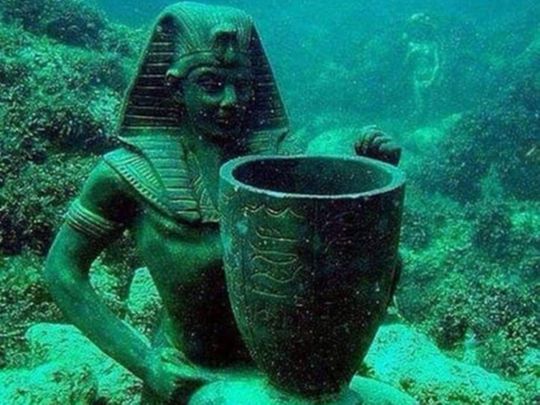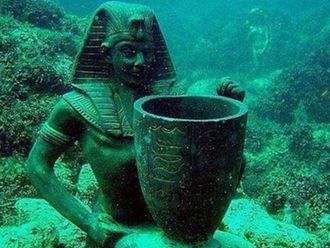
Imagine a bustling ancient world – sprawling cities, dotted with grand statues of animals and sculptures of important figures, with homes and businesses and places of entertainment, all providing insight into age-old civilisations. Now, imagine it all under the ocean.
Click start to play today’s Crossword, where you can identify continents that are both real and imagined.
Forget the lost city of Atlantis. Our world is full of incredible sunken cities that actually existed long ago, and they are just as amazing as the legend. Here are a few that are truly astonishing:
Cleopatra’s Kingdom
In 1998, a team of marine archaeologists began excavating the ocean floor, off the shore of Alexandria, Egypt. They had discovered the royal palace of the last queen of Egypt – Cleopatra. The palace, which took up almost the entire island of Antirhodos, had been lost for 1,600 years.
Antirhodos was reportedly so beautiful, it rivalled the beloved Greek isle of Rhodes. Anyone who docked on the island passed through sweeping red-granite columns of pillars, each decked with a crown, leading the way to the queen’s palace. The massive palace itself was breathtaking, surrounded by sphinxes and statues of deities.
But about 400 years after Cleopatra’s death, the palace was assaulted by earthquakes and tsunamis that submerged the entire island. And there on the ocean floor, the palace lay buried for centuries, before it was finally discovered in the 1990s. Amazingly, many of the artifacts were still intact, including the columns, several statues, artwork, and the foundations of the palace. About 20,000 relics were recovered and are now displayed in museums around the world. Today, divers can explore the remains of the underwater palace and experience the legendary location for themselves.
Bay of Cambay
Indians call it Dwarka (meaning “the golden city”), in honour of the ancient submerged city belonging to the Hindu deity Krishna. The discovery of the sunken 8km-long and 3km-wide city in the Gulf of Khambhat (historically known as the Bay of Cambay), India, was a gamechanger for anthropologists. The reason is because it was built 9,500 years ago – more than 5,000 years before the first great cities began to appear in Mesopotamia. It changed our understanding of human history, and caused historians to reconsider the entire model of the origins of civilisation.
The city was lost, and buried under 120 feet of water, when the ice caps melted at the end of the last Ice Age, around 9,000 years ago. Amazingly, some artifacts survived the years and tides – pottery shards, microliths, hearth materials, fossilised bones and even a tooth were discovered.
Yonaguni-Jima
Imagine swimming in the ocean and stumbling upon a vast complex of ancient sunken ruins. That’s what happened to a sport diver in 1995, when he was exploring an area 109km away from the east coast of Taiwan, near Yonaguni Island, Japan. The ruins he found are believed to be the remains of Japan’s own version of Atlantis – a 5,000-year-old city that was lost to time. In the centre of the city is a gigantic pyramid that once rose 82 feet above the ground. With staircases, hallways and carved stones, the intricate and complex structure indicates a highly sophisticated civilisation.
What do you think of these real-life sunken cities? Play today’s Crossword and let us know at games@gulfnews.com.






